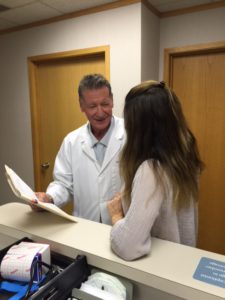What is optimum hormone replacement?
In this section Dr N discusses optimal hormone replacement regimens.
Few women in the United States are on an optimal hormone replacement regimen. It is always sub-optimal to be on oral estrogen. The issue becomes not whether to use hormone replacement, but how.
Orally administered estrogen is transported to the liver and during its metabolism induces the liver to produce undesirable elevations of a number of substances. Oral estrogen raises the level of triglycerides and C – reactive protein (CRP), as well as increasing insulin resistance.
All of these alterations are known to be associated with an increased risk of cardiovascular events. In addition, levels of Sex Hormone Binding Globulin (SHGB) are elevated, which has the effect of decreasing libido, sexual response and energy levels.
Optimum estrogen replacement is always non-oral and utilizes estradiol, the biologically active form of estrogen secreted by the ovary. It is delivered intact into the bloodstream by the use of a transdermal patch, gel, cream or subcutaneous implant.
In contrast to oral hormone replacement, these methods do not cause unwanted elevations of liver substances. In those instances where symptoms persist, an implant of an estradiol pellet is almost always effective.
In women who have had their ovaries removed, or are deficient in androgen production, testosterone can be safely administered non-orally and will enhance libido, sexual response, preservation of lean body mass and sense of well being.
Progesterone
When the uterus is present, administration of a progestin is almost always indicated to prevent the development of abnormal changes of the uterine lining associated with unopposed estrogen stimulation.
Natural progesterone is the hormone of choice, but as it is relatively weak in its activity an alternate form of progesterone is often necessary. The progesterone can be administered orally, vaginally, or in some instances by transdermal patch, or intrauterine device.
It is most physiologic to use the progesterone for 12 days every 4-8 weeks depending on individual response. However, some women find that the “withdrawal bleeding” associated with progesterone given at intervals is unacceptable. In those instances, the use of a combined estrogen-progestin patch, although not as physiologic, can be useful. It is also important to note that some women are intolerant to progesterone experiencing PMS-like symptoms. Altering the type of progesterone, dose or method of administration can reduce this problem.
Important considerations
Hormone replacement with Prempro appears to have a less favorable risk-benefit profile than other replacement preparations, particularly those that are non-oral and those where a progestin component is not used continuously. This is “old news” and has been recognized by menopausal experts since the latter part of the 1990’s.
If your doctor has suggested that you discontinue hormone replacement because of the Heart and Estrogen/progestin Replacement Study Follow Up (HERS II) and The Woman’s Health Initiative (WHI) study both (both published in the Journal of the American Medical Association in July), ask the following two questions: Have you read either of the studies and why any of the recommendations apply to me? What are the short and long-term effects of hormone deficiency on my health, longevity and quality of life?
If you are on an orally administered estrogen consider switching to a non-oral preparation containing estradiol. If a man in the United States was determined to be hormone deficient, he would almost certainly and without trepidation be offered hormone replacement.
Whether you choose to be a user, or non-user of hormone replacement this decision is yours and cannot be dictated by your physician. Remember: “A woman in the autumn of her life is entitled to an Indian summer rather than a winter of discontent.”
Dr. Jerry Nosanchuk is a practicing physician who has specialized in the care of menopausal women for over 30 years. His office is located in Bingham Farms, Michigan. Appointments with Dr. Nosanchuk can be made by calling: (248) 644-7200 and speaking to Caroline Monday through Friday from 10AM to 6PM
IMPORTANT: This website is for educational purposes only. It is not intended to suggest a specific therapy for any individual and must not be construed to establish a physician patient relationship.
